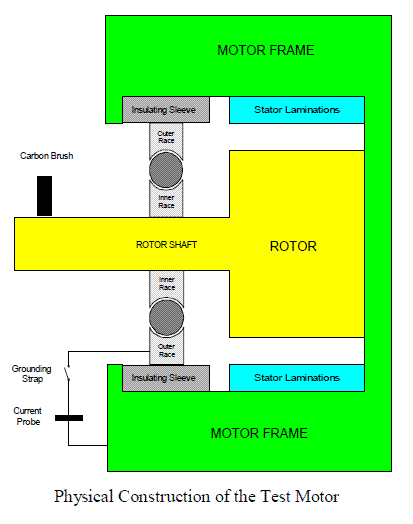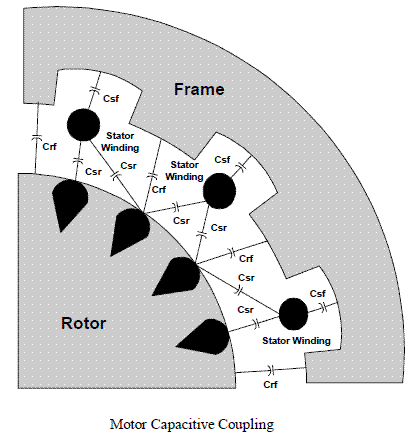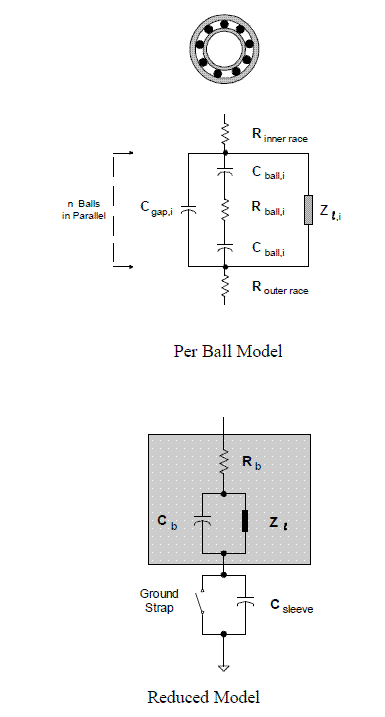Alger investigated shaft and bearing currents in the 1920’s. Exciting the induction motor with sine waves provided a reference condition. Measurements of the stator neutral to ground and rotor to ground voltages and rotor current were made while operating the induction machine at no-load and 60 Hz. The results of those tests are shown in Figure below. EDM currents were not detected. The 60 volt stator neutral voltage induced a 1 volt rotor voltage, a 60 to 1 reduction. This rotor shaft voltage level is at the upper end of the standards.  Figure below shows the physical construction of the test motor. Both the drive and non drive ends of the rotor were outfitted with an insulated bearing support sleeve, which isolated the rotor bearings from the motor frame. This provided a measurement of the rotor open circuit voltage, and when shorted by the grounding strap, simulates an actual bearing mounting. In addition, the grounding strap provides a mechanism for measuring the bearing to ground current. Figure shows a carbon brush for measuring the rotor voltage and investigating solutions to the EDM bearing current problem. The motor had 48 stator slots and 64 rotor bars.
Figure below shows the physical construction of the test motor. Both the drive and non drive ends of the rotor were outfitted with an insulated bearing support sleeve, which isolated the rotor bearings from the motor frame. This provided a measurement of the rotor open circuit voltage, and when shorted by the grounding strap, simulates an actual bearing mounting. In addition, the grounding strap provides a mechanism for measuring the bearing to ground current. Figure shows a carbon brush for measuring the rotor voltage and investigating solutions to the EDM bearing current problem. The motor had 48 stator slots and 64 rotor bars.  Figure below depicts the capacitive coupling relevant to the development of the model. The stator to frame capacitance (Csf) is a distributed element representing the capacitive coupling to frame along the length of the stator conductors. For most investigations, magnetic coupling of the stator and rotor is sufficient. But with the high dv/dt present with modern power devices, capacitive coupling considerations cannot be ignored. Therefore, the stator to rotor capacitance (Csr) and the rotor to frame capacitance (Crf) are included.
Figure below depicts the capacitive coupling relevant to the development of the model. The stator to frame capacitance (Csf) is a distributed element representing the capacitive coupling to frame along the length of the stator conductors. For most investigations, magnetic coupling of the stator and rotor is sufficient. But with the high dv/dt present with modern power devices, capacitive coupling considerations cannot be ignored. Therefore, the stator to rotor capacitance (Csr) and the rotor to frame capacitance (Crf) are included.  The bearings, lubricating film, and insulating sleeve present a combination of capacitances, resistances, and a nonlinear impedance, Figure below.
The bearings, lubricating film, and insulating sleeve present a combination of capacitances, resistances, and a nonlinear impedance, Figure below.  First there exists an inner and outer race resistance. Then, depending on the physical construction, the bearing consists of n balls in parallel; each ball having an effective resistance (Rball,i). In addition, each ball is immersed in the lubricating film; thus, each ball develops two capacitances (Cball,i) linking the ball to the inner and outer races. The ball portion of the bearing model, therefore, consists of n parallel combinations of (Cball,i) and (Rball,i). Between balls, the inner and outer races are separated by the lubricant, which forms a dielectric barrier. Therefore, a capacitance (Cgap,i) is formed between each pair of balls, resulting in n parallel capacitors. The nonlinear impedance (Zl,i) accounts for the mechanical and electrical abnormalities and randomness of the bearing. Combining the individual components results in a reduced order bearing model, which is compatible with the motor drive models employed in simulations and analyses. The reduced order model consists of a resistance (Rb) in series with the parallel combination of an effective capacitance (Cb) and a nonlinear impedance (Zl). Finally, the insulating sleeve adds a series capacitance (Csleeve) that is shorted when the grounding strap is employed. For exampel combining the bearing model with a simple inverter/motor model yields the model of Figure below. Here, the inverter is modeled as three line to neutral voltages with a neutral to ground zero sequence source. This model allows the inverter’s voltages to be examined as positive, negative, and zero sequence sets. The motor is represented as two sets of three phase windings; one each for the stator and rotor windings. The capacitive coupling from stator to frame is lumped at the neutral of the stator winding and the capacitive coupling between the stator and rotor connects the stator and rotor zero sequence networks. Finally, the rotor to frame capacitance and bearing provide the paths to ground from the rotor shaft, here represented by the neutral of the rotor.
First there exists an inner and outer race resistance. Then, depending on the physical construction, the bearing consists of n balls in parallel; each ball having an effective resistance (Rball,i). In addition, each ball is immersed in the lubricating film; thus, each ball develops two capacitances (Cball,i) linking the ball to the inner and outer races. The ball portion of the bearing model, therefore, consists of n parallel combinations of (Cball,i) and (Rball,i). Between balls, the inner and outer races are separated by the lubricant, which forms a dielectric barrier. Therefore, a capacitance (Cgap,i) is formed between each pair of balls, resulting in n parallel capacitors. The nonlinear impedance (Zl,i) accounts for the mechanical and electrical abnormalities and randomness of the bearing. Combining the individual components results in a reduced order bearing model, which is compatible with the motor drive models employed in simulations and analyses. The reduced order model consists of a resistance (Rb) in series with the parallel combination of an effective capacitance (Cb) and a nonlinear impedance (Zl). Finally, the insulating sleeve adds a series capacitance (Csleeve) that is shorted when the grounding strap is employed. For exampel combining the bearing model with a simple inverter/motor model yields the model of Figure below. Here, the inverter is modeled as three line to neutral voltages with a neutral to ground zero sequence source. This model allows the inverter’s voltages to be examined as positive, negative, and zero sequence sets. The motor is represented as two sets of three phase windings; one each for the stator and rotor windings. The capacitive coupling from stator to frame is lumped at the neutral of the stator winding and the capacitive coupling between the stator and rotor connects the stator and rotor zero sequence networks. Finally, the rotor to frame capacitance and bearing provide the paths to ground from the rotor shaft, here represented by the neutral of the rotor.  Reference: Effect of PWM Inverters on AC Motor Bearing Currents and Shaft Voltages Jay Erdman, Russel J. Kerkman, Dave Schlegel, and Gary Skibinski
Reference: Effect of PWM Inverters on AC Motor Bearing Currents and Shaft Voltages Jay Erdman, Russel J. Kerkman, Dave Schlegel, and Gary Skibinski
